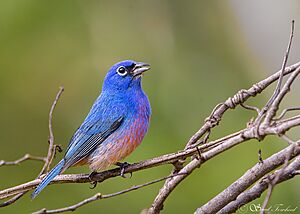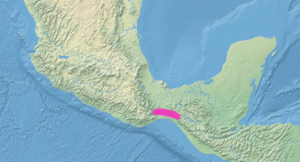Rose-bellied bunting facts for kids
Quick facts for kids Rose-bellied bunting |
|
|---|---|
 |
|
| Conservation status | |
| Scientific classification | |
| Genus: |
Passerina
|
| Species: |
rositae
|
 |
|
| Range of the rose-bellied bunting | |
The rose-bellied bunting, also known as Rosita's bunting (Passerina rositae), is a beautiful bird found only in a small part of southern Mexico. It belongs to the Cardinalidae family, which includes colorful birds like cardinals and grosbeaks. This bird is special because it lives nowhere else in the world!
Contents
What Does It Look Like?
The rose-bellied bunting is a small bird, about 13.5 to 14.5 cm (5.3 to 5.7 in) long. That's about the length of your hand! It weighs around 19.5 to 20.5 g (0.69 to 0.72 oz), which is lighter than a few coins.
- Males: Adult male buntings are very striking. Their head is a purplish-blue color. The rest of their upper body is a bright electric blue. This blue gets lighter as it goes towards their tail. Their chin is grayish, and their throat and chest are blue. The most unique part is their belly, which is a lovely salmon pink!
- Females: Adult female buntings are less colorful. Their head and upper body are gray-brown. They might have a slight bluish tint near their tail. Their underside is a soft pinkish-tan color. It's a bit warmer on their throat and gets paler towards their lower belly.
Where Does It Live?
The rose-bellied bunting lives in a very specific area. You can find it along the Pacific coast of the Isthmus of Tehuantepec. This area is in eastern Oaxaca and western Chiapas, two states in southern Mexico. There's also been one sighting further east in Chiapas, in a special protected area called El Triunfo Biosphere Reserve.
These birds like to live in places that are dry or semi-dry. They prefer thorn forests, which have lots of thorny plants. They also live in gallery forests, which are moister forests found along rivers. Sometimes, they can even be found in swamp forests. They live at elevations from 180 to 800 m (590 to 2,620 ft) above sea level.
What Does It Eat?
Rose-bellied buntings usually look for food alone or in pairs. They search for their meals in the lower and middle parts of the trees and bushes where they live. Their diet mainly includes seeds from grasses. They also enjoy eating fruit from various trees and bushes.
Reproduction and Life Cycle
Scientists have found and studied only a couple of rose-bellied bunting nests so far.
- One nest was found in late July and had fresh eggs.
- Another nest, found in late June, had eggs that were already well on their way to hatching.
The nests are shaped like open cups. They are made from dead leaves and bark. The inside is lined with softer, finer materials. These nests are usually placed in the forks of small, young trees. One nest had three eggs, while the other had four. There isn't much more information known about how these birds raise their young.
What Does It Sound Like?
The rose-bellied bunting has a sweet and slightly rough-sounding song. You can listen to an example of its song online [1]. Its call is described as a "wet 'plik' or 'plek'" sound [2].
Is It in Danger?
The IUCN (International Union for Conservation of Nature) is a group that checks on how safe different animal species are. They have listed the rose-bellied bunting as "Near Threatened." This means the bird is not in immediate danger of disappearing, but it could be in the future.
The reason it's "Near Threatened" is because it lives in such a small area. Also, its home is slowly being damaged. This damage comes from things like people clearing land and building new roads or buildings. Protecting its habitat is very important to keep these beautiful birds safe!


